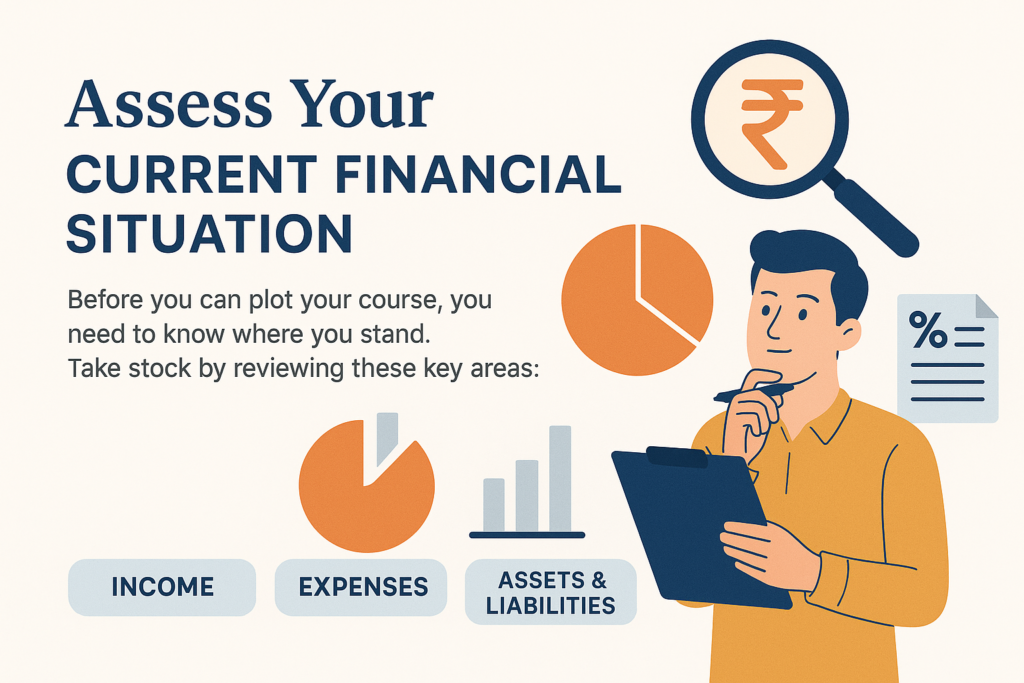In a world where financial uncertainty is more the norm than the exception, planning your finances is no longer optional but mandatory. Whether you’re dreaming of early retirement, aiming to buy your first home, or simply want to sleep better knowing you’re financially secure, financial planning is the roadmap that turns those aspirations into reality.
But what exactly is financial planning? Why is it so important today? And how can you do it effectively, even if you’re not a finance expert? Let’s explore.
Understanding Financial Planning

Financial planning is the process of evaluating your current financial situation, defining your financial goals, and creating a comprehensive strategy to achieve them. It isn’t just about investing or saving; it’s about taking a holistic look at your income, expenses, savings, investments, debts, insurance, and future aspirations.
A sound financial plan helps you:
- Set short, medium, and long-term financial goals.
- Build resilience against economic shocks.
- Reduce financial stress by having a clear money strategy.
- Maximize wealth through efficient budgeting, saving, and investing.
- Plan for major life events like education, marriage, buying property, or retirement.
It’s not a one-time activity; it’s an ongoing process that evolves as your life, priorities, and financial circumstances change.
The State of Personal Finance Today: A Reality Check
Despite rising incomes, financial literacy and long-term planning remain significant challenges in India. Here are some key statistics that highlight why financial planning is more critical than ever for Indian individuals and families:
- Only 27% of Indian adults are financially literate, according to a global survey by Standard & Poor’s. This places India behind countries like China, South Africa, and Brazil, and shows a clear gap in basic understanding of interest, inflation, and risk diversification.
- A 2025 Marcellus-D&B Wealth Survey found that 43% of Indian high-net-worth individuals (HNIs) save less than 20% of their income. Even among the wealthy, consistent saving and investment behavior is not yet a norm, pointing to a lack of structured financial planning.
- According to a 2024 survey by Max Life Insurance and Kantar, just 33% of Indians feel “financially secure”. While the awareness of financial planning is increasing, the actual confidence in one’s ability to handle future expenses is still low.
- The EPFO’s annual report (2023-24) indicates that over 90% of India’s workforce lacks any formal pension coverage, highlighting a huge gap in retirement preparedness, especially in the unorganized sector.
- A 2023 SEBI study showed that less than 10% of Indian households invest in equity markets, with a majority still relying on traditional instruments like gold, fixed deposits, or real estate—many of which underperform when adjusted for inflation.
- Only 10% of Indian respondents with retirement goals take advice from certified financial planners, according to a Business Today report. Many still rely on friends, family, or informal advice, which can be risky given the complexity of modern financial products.
These statistics reflect a dual reality: while India is a growing economy with increasing income levels and financial products, a large portion of its population is either under-informed or under-prepared when it comes to managing money for long-term success.
Clearly, there’s a widening gap between what people need financially and what they’re actually doing. But the good news is that effective financial planning can bridge that gap, no matter where you start.
How to Do Financial Planning Effectively
1. Define Your Financial Goals

The first step in financial planning is clarity. What do you want to achieve with your money?
Your goals should be SMART—Specific, Measurable, Achievable, Relevant, and Time-bound. For instance, instead of saying, “I want to save more,” you could aim for, “I want to save ₹10 lakhs in the next three years for a down payment.”
Goals typically fall into three buckets:
- Short-term (0–3 years): Emergency fund, paying off credit cards.
- Mid-term (3–7 years): Buying a car, saving for a wedding.
- Long-term (7+ years): Retirement, children’s education, property investments.
2. Assess Your Current Financial Situation

Start by creating a net worth statement—list your assets (savings, investments, property) and liabilities (loans, credit card dues). Then, track your cash flow for a few months to understand your income and spending patterns.
Use this data to answer key questions:
- Am I living within my means?
- Where can I cut back on spending?
- Am I saving enough every month?
Even free tools like spreadsheets or apps like Mint, YNAB, or Walnut can help visualize your finances better.
3. Create a Realistic Budget
Budgeting is the cornerstone of any financial plan. One of the most popular approaches is the 50/30/20 rule:
- 50% for needs (rent, groceries, utilities).
- 30% for wants (dining, subscriptions, travel).
- 20% for savings and debt repayment.
If your current expenses don’t fit this model, don’t worry. Use it as a benchmark and adapt gradually.
4. Build an Emergency Fund
Life is unpredictable. An emergency fund ensures that unexpected expenses, like a job loss or medical emergency, don’t derail your entire financial plan.
Aim to save 3–6 months’ worth of living expenses in a highly liquid, low-risk account. This safety net is not an investment; it’s insurance for your financial goals.
5. Eliminate and Manage Debt Wisely
High-interest debt, especially from credit cards, is a major barrier to financial freedom.
Use the snowball method (start with the smallest debt) or the avalanche method (start with the highest-interest debt) to pay off what you owe.
If your debts are significant, consider consolidation or refinancing options to lower interest costs.
6. Invest for the Future
Once you have your basics covered, investing helps grow your wealth and beat inflation.
Depending on your goals and risk appetite, you can explore:
- Stocks and Mutual Funds for long-term growth.
- Fixed Deposits and Bonds for stability.
- Retirement schemes like EPF, PPF, or NPS in India; 401(k)s and IRAs in the U.S.
- Real estate for income or capital appreciation.
Ensure your portfolio is diversified and reviewed at least annually. Avoid investing just because it’s trending (remember crypto booms and busts?).
7. Insure What You Can’t Afford to Lose
Insurance isn’t exciting, but it’s vital.
- Health insurance protects you from catastrophic medical costs.
- Life insurance ensures your dependents are financially secure in your absence.
- Disability or term insurance guards against income loss.
Think of insurance as a financial safety net, not an investment.
8. Plan for Retirement Early
Retirement isn’t an age, it’s a financial condition.
The earlier you start, the more you benefit from compound interest. For example, saving ₹5,000 per month starting at age 25 can yield over ₹2.5 crores by retirement, assuming moderate returns.
Determine how much you’ll need to live comfortably post-retirement, and work backward to see how much you must save monthly.
9. Minimize Taxes Legally
No one enjoys paying more taxes than necessary.
- Use tax-advantaged accounts like 401(k), HSA, or Roth IRA in the U.S.
- In India, leverage deductions under Sections 80C, 80D, and 24(b) for PPF, ELSS, insurance premiums, and home loan interest.
Tax planning is not about evasion—it’s about optimization.
10. Review, Adjust, Repeat
Life changes—so should your financial plan.
Review your goals and finances at least once a year or after major life events like marriage, having kids, or changing jobs. Rebalance your investments, increase your insurance coverage, or modify your budget as needed.
Consistency and flexibility go hand-in-hand in effective financial planning.
The Role of Professional Advisors
While DIY financial planning works for many, there are situations where expert guidance is invaluable. Certified financial planners (CFPs), wealth managers, and tax consultants can help you make informed decisions, especially when dealing with complex assets, retirement transfers, or succession planning.
Surprisingly, only 10% of Indians with a retirement strategy consult certified advisors, according to Business Today. This low uptake indicates the need for more accessible and trustworthy financial education and planning.
Final Thoughts
Financial planning isn’t just about numbers; it’s about creating a secure and fulfilling life. It’s about being in control, not just reacting. Whether you’re just starting out or reevaluating your financial future, the best time to start planning was yesterday, the next best time is now.
With inflation, rising living costs, and longer life expectancies, a proactive financial plan isn’t a luxury; it’s a necessity. So take charge, define your goals, and build the future you envision, one rupee or dollar at a time.



